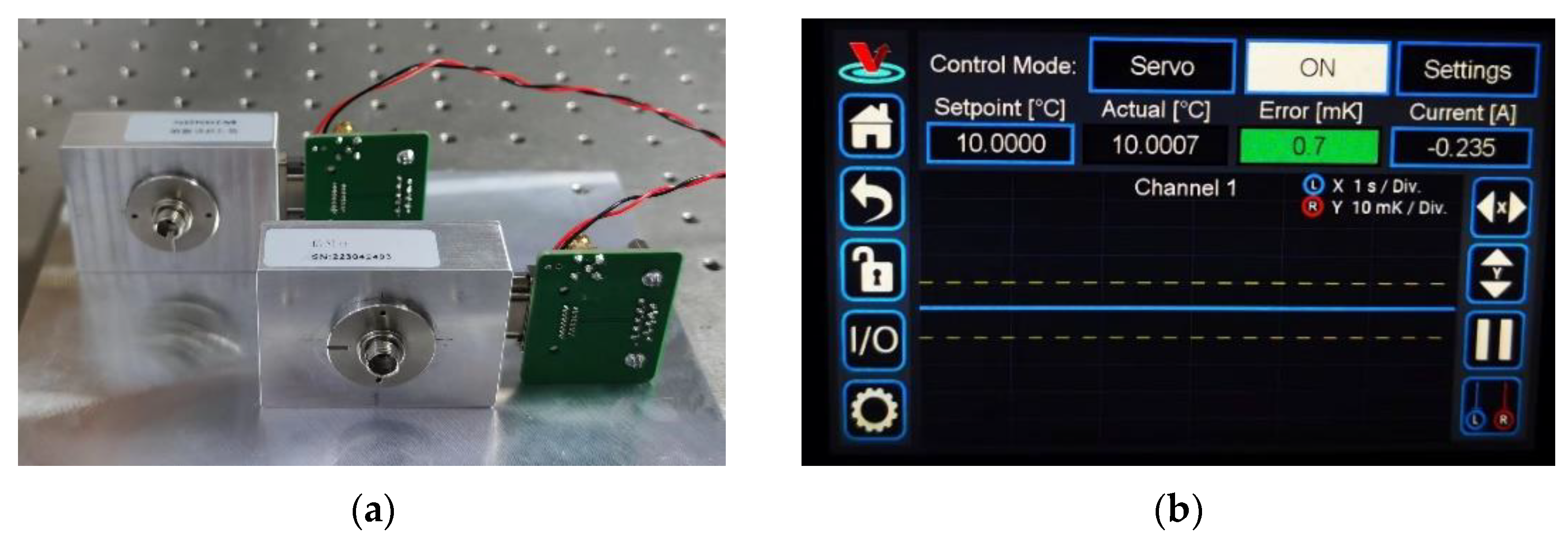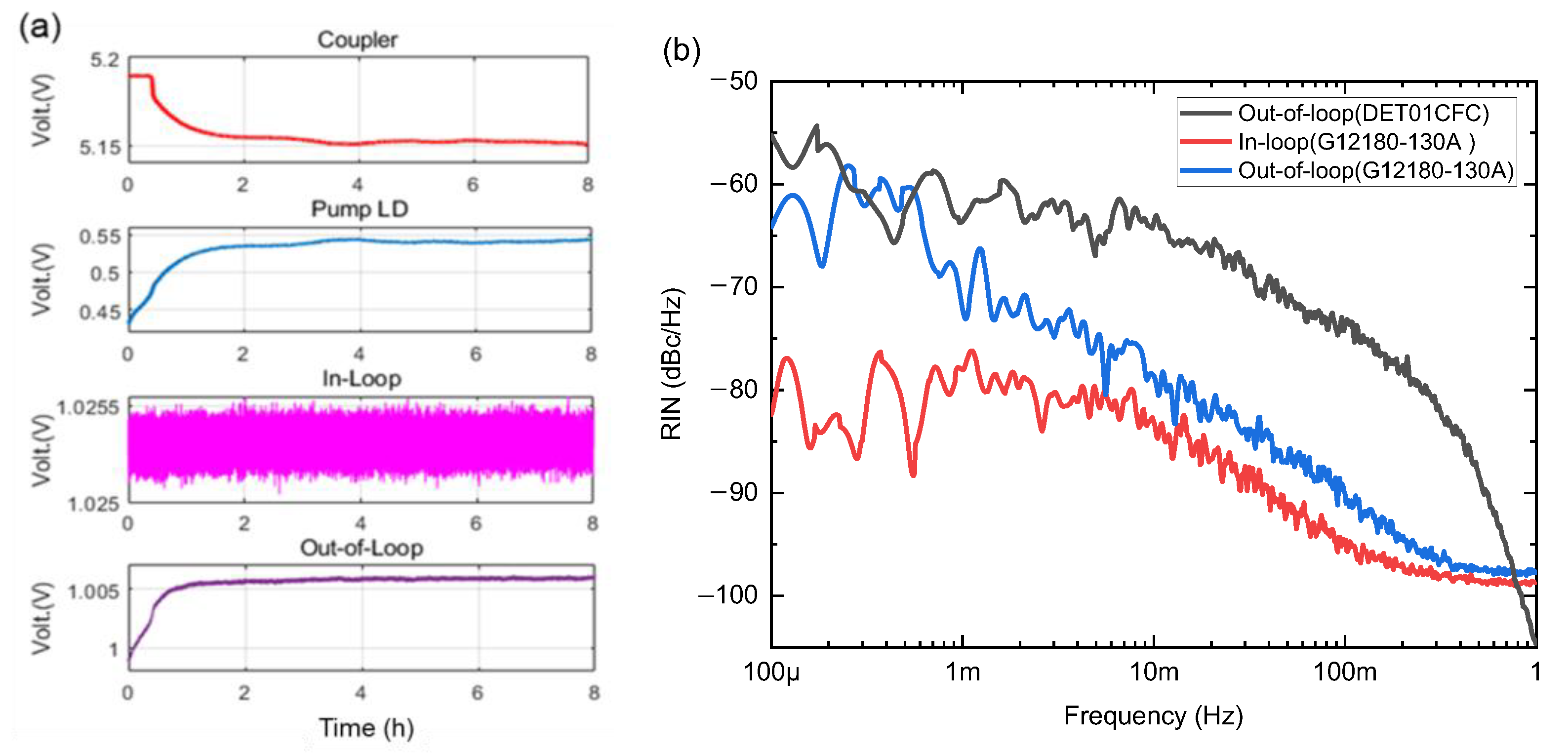Yb-Doped All-Fiber Amplifier with Low-Intensity Noise in mHz Range Oriented to Space-Borne Gravitational Wave Detection
Abstract
:1. Introduction
2. Theoretical Noise Model
3. Experimental Setup
4. Results and Discussion
4.1. Power, Slope Efficiency, and Optical Spectrum
4.2. Measurement of Additional Linewidth
4.3. Measurement of the RIN
4.4. Optimization of the RIN
5. Conclusions
Author Contributions
Funding
Institutional Review Board Statement
Informed Consent Statement
Data Availability Statement
Conflicts of Interest
References
- Hall, J. Stabilized Lasers and Precision Measurements. Science 1978, 202, 147–156. [Google Scholar] [CrossRef] [PubMed]
- Tünnermann, A.; Schreiber, T.; Limpert, J. Fiber lasers and amplifiers: An ultrafast performance evolution. Appl. Opt. 2010, 49, F71–F78. [Google Scholar] [CrossRef]
- Wellmann, F.; Steinke, M.; Wessels, P.; Bode, N.; Meylahn, F.; Willke, B.; Overmeyer, L.; Neumann, J.; Kracht, D. Performance study of a high-power single-frequency fiber amplifier architecture for gravitational wave detectors. Appl. Opt. 2020, 59, 7945–7950. [Google Scholar] [CrossRef] [PubMed]
- Willke, B. Stabilized lasers for advanced gravitational wave detectors. Laser Photon. Rev. 2010, 4, 780–794. [Google Scholar] [CrossRef]
- Numata, K.; Yu, A.; Jiao, H.; Merritt, S.; Micalizzi, F.; Fahey, M.; Camp, J.; Krainak, M. Progress and plans for a U.S. laser system for the LISA mission. In Proceedings of the International Conference on Space Optics—ICSO 2018, Chania, Greece, 9–12 October 2018. [Google Scholar]
- Guiraud, G.; Traynor, N.; Santarelli, G. High-power and low-intensity noise laser at 1064 nm. Opt. Lett. 2016, 41, 4040–4043. [Google Scholar] [CrossRef] [PubMed]
- Xue, M.; Gao, C.; Niu, L.; Zhu, S.; Sun, C. Influence of amplified spontaneous emission on laser linewidth in a fiber amplifier. Appl. Opt. 2020, 59, 2610. [Google Scholar] [CrossRef] [PubMed]
- Gong, Y.G.; Luo, J.; Wang, B. Concepts and status of Chinese space gravitational wave detection projects. Nat. Astron. 2021, 5, 881–889. [Google Scholar] [CrossRef]
- Numata, K.; Yu, W.; Jiao, H.; Merritt, A.; Micalizzi, F.; Fahey, E.; Camp, B.; Krainak, A. Laser system development for the LISA (Laser Interferometer Space Antenna) mission. In Solid State Lasers XXVIII: Technology and Devices; SPIE: Bellingham, WA, USA, 2019. [Google Scholar]
- Danzmann, K.; the LISA Study Team. LISA—An ESA cornerstone mission for the detection and observation of gravitational waves. Adv. Space Res. 2003, 32, 1233–1242. [Google Scholar] [CrossRef]
- Luo, J.; Chen, L.S.; Duan, H.Z.; Gong, Y.G.; Hu, S.; Ji, J.; Liu, Q.; Mei, J.; Milyukov, V.; Sazhin, M. Tianqin: A space-borne gravitational wave detector. Class. Quantum Grav. 2016, 33, 035010. [Google Scholar] [CrossRef]
- Luo, Z.; Wang, Y.; Wu, Y.; Hu, W.; Jin, G. The Taiji program: A concise overview. Prog. Theor. Exp. Phys. 2021, 2021, 05A108. [Google Scholar] [CrossRef]
- Danzmann, K.; Rüdiger, A. LISA technology—Concepts, status, prospects. Class. Quantum Grav. 2003, 20, S1–S9. [Google Scholar] [CrossRef]
- Peterseim, M.; Brozek, O.S.; Danzmann, K.; Freitag, I.; Rottengatter, P.; Tünnermann, A.; Welling, H. Laser development and laser stabilization for the space-borne gravitational wave detector LISA. AIP Conf. Proc. 1998, 456, 148–155. [Google Scholar]
- Numata, K.; Chen, J.R.; Camp, J. Fiber laser development for LISA. J. Phys. Conf. Ser. 2010, 228, 012043. [Google Scholar] [CrossRef]
- Tröbs, M.; Weßels, P.; Fallnich, C. Power- and frequency-noise characteristics of an Yb-doped fiber amplifier and actuators for stabilization. Opt. Express. 2005, 13, 2224–2235. [Google Scholar] [CrossRef]
- Camp, J.J.; Numata, K.; Krainak, M. Progress and Plans for a US Laser System for LISA. J. Phys. Conf. Ser. 2017, 840, 012013. [Google Scholar] [CrossRef]
- Dahl, K.; Cebeci, P.; Fitzau, O.; Giesberts, M.; Greve, C.; Krutzik, M.; Peters, A.; Pyka, S.; Sanjuan, J.; Schiemangk, M.; et al. A New Laser Technology for LISA. Proc. SPIE 2018, 11180, 111800C. [Google Scholar]
- Luo, J.; Bai, Y.; Cai, L.; Cao, B.; Chen, W.-M.; Chen, Y.; Cheng, D.-C.; Ding, Y.-W.; Duan, H.-Z.; Gou, X.; et al. The first-round result from the TianQin-1 satellite. Class. Quantum Grav. 2020, 37, 185013. [Google Scholar] [CrossRef]
- Sun, G.; Chen, D.; Xin, G.; Cai, H.; Chen, W. High stability laser source for Taiji-1 satellite. Int. J. Mod. Phys. A 2021, 36, 2140006. [Google Scholar] [CrossRef]
- Buchler, B.; Huntington, E.; Harb, C.; Ralph, T. Feedback control of laser intensity noise. Phys. Rev. A. 1998, 57, 1286–1294. [Google Scholar] [CrossRef]
- Cowle, G.; Morkel, P.; Laming, R.; Payne, D. Spectral broadening due to fibre amplifier phase noise. Electron. Lett. 1990, 26, 424–425. [Google Scholar] [CrossRef]
- Okamura, H.; Iwatsuki, K. Spectral linewidth broadening in Er-doped-fibre amplifiers measured with less than 1.4 kHz linewidth light source. Electron. Lett. 1990, 26, 1965–1967. [Google Scholar] [CrossRef]
- Möller, L. Novel aspects of spectral broadening due to fiber amplifier phase noise. IEEE J. Quantum Electron. 1998, 34, 1554–1558. [Google Scholar] [CrossRef]
- Chen, M.; Zhou, M.; Wang, F.; Chen, W. Ultra-narrow linewidth measurement based on Voigt profile fitting. Opt. Express. 2015, 23, 6803–6808. [Google Scholar] [CrossRef] [PubMed]












| Parameter | DET01CFC/M | G12180-130A |
|---|---|---|
| Wavelength Range/nm | 800~1700 | 900~1670 |
| Response/(A/W) @ 1064 nm | 0.65 | 0.6 |
| Bandwidth/MHz | 1200 | 2.5 |
| NEP (λp)/(W/Hz1/2) | 4.50 × 10−15 | 4.90 × 10−15 |
| Dark Current/nA | 0.235 | 0.15 |
| Bias Voltage/V | 12 | 1.2 |
| Cooling | — | One-stage TE-cooled |
Disclaimer/Publisher’s Note: The statements, opinions and data contained in all publications are solely those of the individual author(s) and contributor(s) and not of MDPI and/or the editor(s). MDPI and/or the editor(s) disclaim responsibility for any injury to people or property resulting from any ideas, methods, instructions or products referred to in the content. |
© 2023 by the authors. Licensee MDPI, Basel, Switzerland. This article is an open access article distributed under the terms and conditions of the Creative Commons Attribution (CC BY) license (https://creativecommons.org/licenses/by/4.0/).
Share and Cite
Wang, Z.; Wang, J.; Li, F.; Li, Y.; Tian, L.; Liu, Q. Yb-Doped All-Fiber Amplifier with Low-Intensity Noise in mHz Range Oriented to Space-Borne Gravitational Wave Detection. Appl. Sci. 2023, 13, 6338. https://doi.org/10.3390/app13106338
Wang Z, Wang J, Li F, Li Y, Tian L, Liu Q. Yb-Doped All-Fiber Amplifier with Low-Intensity Noise in mHz Range Oriented to Space-Borne Gravitational Wave Detection. Applied Sciences. 2023; 13(10):6338. https://doi.org/10.3390/app13106338
Chicago/Turabian StyleWang, Zaiyuan, Jiehao Wang, Fan Li, Yuhang Li, Long Tian, and Qiang Liu. 2023. "Yb-Doped All-Fiber Amplifier with Low-Intensity Noise in mHz Range Oriented to Space-Borne Gravitational Wave Detection" Applied Sciences 13, no. 10: 6338. https://doi.org/10.3390/app13106338
APA StyleWang, Z., Wang, J., Li, F., Li, Y., Tian, L., & Liu, Q. (2023). Yb-Doped All-Fiber Amplifier with Low-Intensity Noise in mHz Range Oriented to Space-Borne Gravitational Wave Detection. Applied Sciences, 13(10), 6338. https://doi.org/10.3390/app13106338






